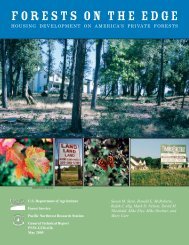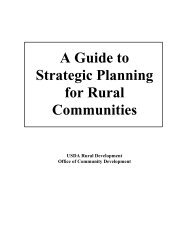Evaluation Sourcebook (.pdf) - School of Natural Resources and ...
Evaluation Sourcebook (.pdf) - School of Natural Resources and ...
Evaluation Sourcebook (.pdf) - School of Natural Resources and ...
- No tags were found...
You also want an ePaper? Increase the reach of your titles
YUMPU automatically turns print PDFs into web optimized ePapers that Google loves.
INTRODUCTION OBJECTIVES THREATS ASSETS STRATEGIESAge class distribution (proportion <strong>of</strong> juveniles, fledglings, saplings vs. adults)Percent <strong>of</strong> forest that qualifies as old growthX What is the population size likely to be next year?Are populations <strong>of</strong> rare species growing more or less rapidly than previous years? Birth rates; frequency <strong>of</strong> reproductive events; litter sizeNumber <strong>of</strong> new recruits per year (recruitment rate; fledgling success)Death or mortality ratesGrowth rate 7Frequency <strong>of</strong> immigration <strong>and</strong> emigrationSex ratioData sources• North American Amphibian Monitoring Program:http://www.pwrc.usgs.gov/naamp/• North American breeding Bird Survey: http://www.pwrc.usgs.gov/bbs/• South Atlantic Migratory Bird Initiative: http://samigbird.fws.gov/• <strong>Natural</strong> Heritage, Audubon or other organization or university surveys• Harvesting records (USFS, timber companies, State hunting/fishing records)• Roadside sightings, point counts or estimatesExampleBobwhite quails in Georgia have declined by more than 70 percent since the 1960s. In orderto address this decline, Georgia’s Department <strong>of</strong> <strong>Natural</strong> <strong>Resources</strong> implemented theBobwhite Quail Initiative (BQI) – a l<strong>and</strong>owner program that improves quail nesting <strong>and</strong>brood rearing habitats (two factors limiting quails) across Georgia's l<strong>and</strong>scape. BQI workswith farml<strong>and</strong> owners <strong>and</strong> helps l<strong>and</strong>owners make habitat changes to their farml<strong>and</strong> so thatit is beneficial to Bobwhite quails. To measure the effect <strong>of</strong> the habitat changes theycompared quail population numbers on BQI farms to farms that did not make any habitatchanges (control farms). The number <strong>of</strong> calling quails (covey-call-counts) served as anindirect measure <strong>of</strong> the number <strong>of</strong> quails at a site. After two years, BQI found that quailpopulations were increasing on BQI farms <strong>and</strong> declining on control farms. This informationprovides concrete feedback on the effectiveness <strong>of</strong> their habitat change program.For more information see:http://georgiawildlife.dnr.state.ga.us/content/displaycontent.asp?txtDocument=1087 A population does not have to be growing to be viable. Many natural populations fluctuate at around zeronet growth. A decline in growth rate indicates the need to look at possible threats to the population.<strong>Evaluation</strong> <strong>Sourcebook</strong> 37






